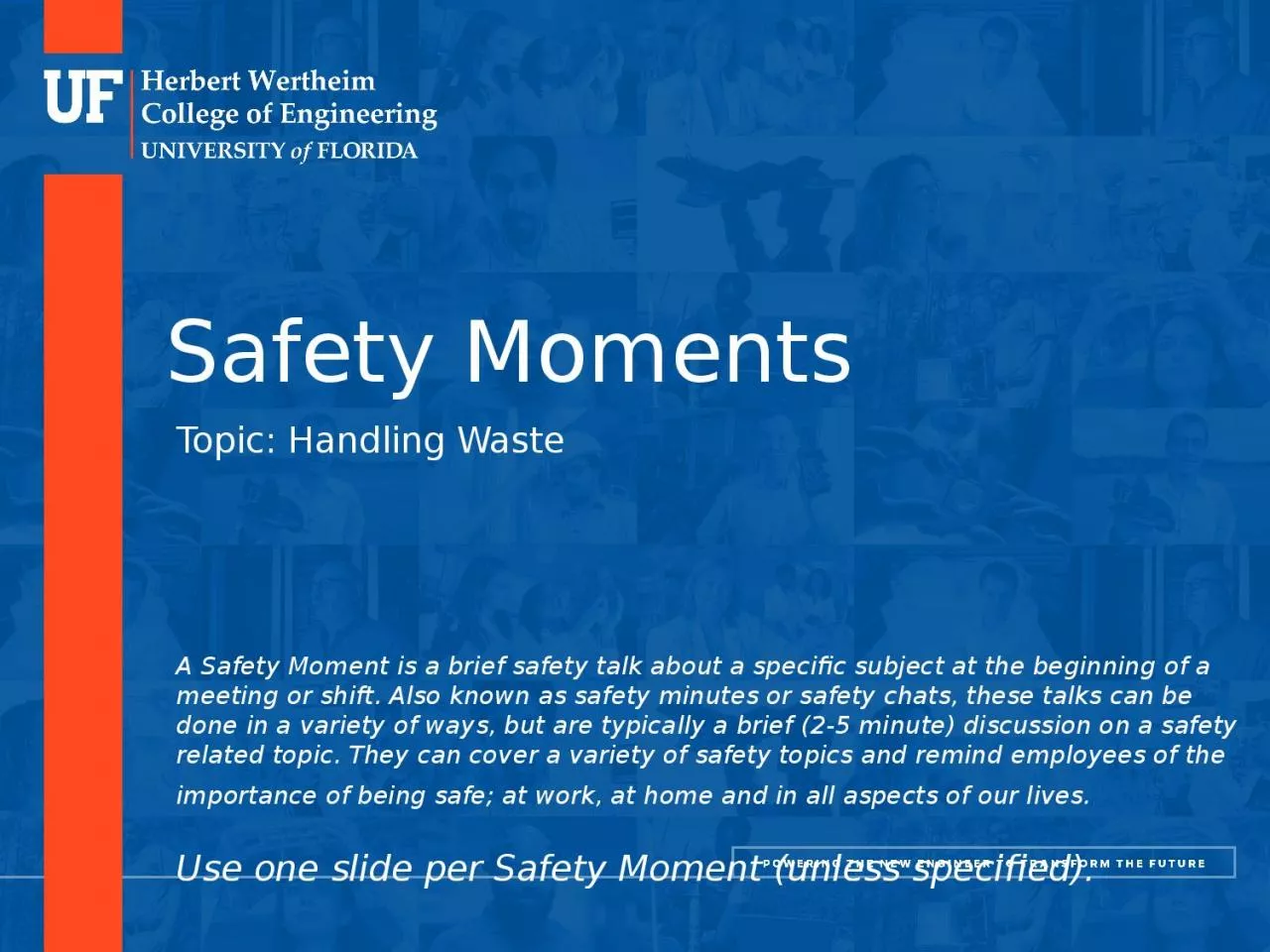

A Safety Moment is a brief safety talk about a specific subject at the beginning of a meeting or shift Also known as safety minutes or safety chats these talks can be done in a variety of ways but are typically a brief 25 minute discussion on a safety related topic They can cover a variety of ID: 1028603
Download Presentation The PPT/PDF document "Safety Moments Topic: Handling Waste" is the property of its rightful owner. Permission is granted to download and print the materials on this web site for personal, non-commercial use only, and to display it on your personal computer provided you do not modify the materials and that you retain all copyright notices contained in the materials. By downloading content from our website, you accept the terms of this agreement.
1. Safety MomentsTopic: Handling WasteA Safety Moment is a brief safety talk about a specific subject at the beginning of a meeting or shift. Also known as safety minutes or safety chats, these talks can be done in a variety of ways, but are typically a brief (2-5 minute) discussion on a safety related topic. They can cover a variety of safety topics and remind employees of the importance of being safe; at work, at home and in all aspects of our lives. Use one slide per Safety Moment (unless specified).
2. Waste determinationsThe best time to think about waste disposal is BEFORE you start the experiment*. Some questions to ask yourself during the planning process:What wastes will I generate and what are their characteristics? How will I store the wastes after they are generated and prior to disposal?Where will you store the wastes?How long will you store the waste? How will you get rid of the wastes? (hazardous or non?)Additional information on waste handling, storage and disposal can be received through proper training: http://www.ehs.ufl.edu/programs/chemrad_waste/hazardous-waste-training/ *document your waste collection and disposal procedures in the SOP
3. Liquid hazardous wasteGeneral Rules for Managing Liquid Hazardous WastesContainers must be closed at all times except when physically adding wasteContainers must be labelled with all chemical constituents (and their approximate % by volume), including waterSegregate liquid waste from solid wastesStore small (<1 gal) containers in a secondary containment (tray or tub)Glass bottles on the floor must be stored in a secondary containment (tray or tub)Leave adequate headspace in liquid containers (~1” is sufficient for a 4L container; leave more or less depending on the size of your waste container)Accumulate any Mercury-containing liquids or compounds in their own container4-liter glass bottles, 10- and 20-liter plastic carboys, and 20-liter metal cans are available at no charge from EH&S by calling 392-8400
4. Flammable Liquids and Solvent WastesSegregate from oxidizers within SAA (separate secondary containment)Do not mix halogenated solvent waste with non-halogenated wasteFor small quantities (<5 gallons), accumulate in glass bottlesFor larger quantities (>5 gallons), accumulate in metal cansEnsure installed grounding straps are attached when pouring into waste containersEnsure area free of heat or open flame
5. Corrosive Liquid WastesSegregate acidic wastes from alkaline wastes within SAA (separate secondary containment)For small quantities (<5 gallons), accumulate in glass bottlesFor larger quantities (>5 gallons), accumulate in plastic carboysNever accumulate corrosive liquids in a metal containerAlways accumulate hydrofluoric acid (“HF”) in a plastic container; NEVER USE GLASS FOR HYDROFLUORIC ACID
6. Solid hazardous wasteGeneral Rules for Managing Solid Hazardous WastesContainers must be closed at all times except when physically adding wasteContainers must be labelled with all chemical constituents or contaminantsSegregate liquid waste from solid wasteDo not dispose of liquid-containing vials in the same container as solid wasteIdentify all chemical hazards on hazardous waste labelsAccumulate any mercury-containing compounds or mercury- contaminated solid wastes in a separate containerDo not dispose of clean lab ware or broken glass as a solid hazardous waste5-gallon plastic buckets and 30-gallon fiberboard drums(with plastic liner) for solid waste accumulation are available from EH&S by calling 392-8400
7. Clean glassware policy (slide 1 of 2)These laboratory items may be disposed of as “Clean Lab Ware,” provided that the item is clean and is not contaminated with hazardous chemicals, radiological materials, or biohazardous materials.Lab glassware (empty bottles, beakers, graduated cylinders, flasks, pipettes, etc.)Lab plastic wares (empty product containers, petri dishes, pipette tips, weighing boats, etc.)Empty vials (including conical tubes, test tubes, centrifuge tubes, etc.)Clean, uncontaminated glovesSharp materials, such as glass slides, broken glassware, pipettes, etc. but DOES NOT INCLUDE METAL NEEDLES, SCALPELS, OR RAZOR BLADEShttp://www.ehs.ufl.edu/programs/chemrad_waste/lab-chem-waste-mgmt/methods-for-managing-specific-laboratory-wastes/labware/
8. Clean glassware policy (slide 2 of 2)The following items are not permitted to be disposed of in the lab’s Clean Lab Ware box.Any item contaminated with a hazardous chemical, radiological, or biohazardous materialNeedles, scalpels, razor blades (must be disposed of in a rigid plastic outer container)Any item marked with a Biohazard symbolRed bags (reserved solely for biohazardous wastes)Used tissue culturesLabs are directed to line a cardboard box with a plastic garbage bag and label the outside of the box “Clean Lab Ware.” Once full, lab workers should seal the box using tape and dispose of the box as follows:Labs not in the Health Science Center: deliver the closed and sealed box to the building’s dumpster.
9. ChemSwapfor surplus chemicals